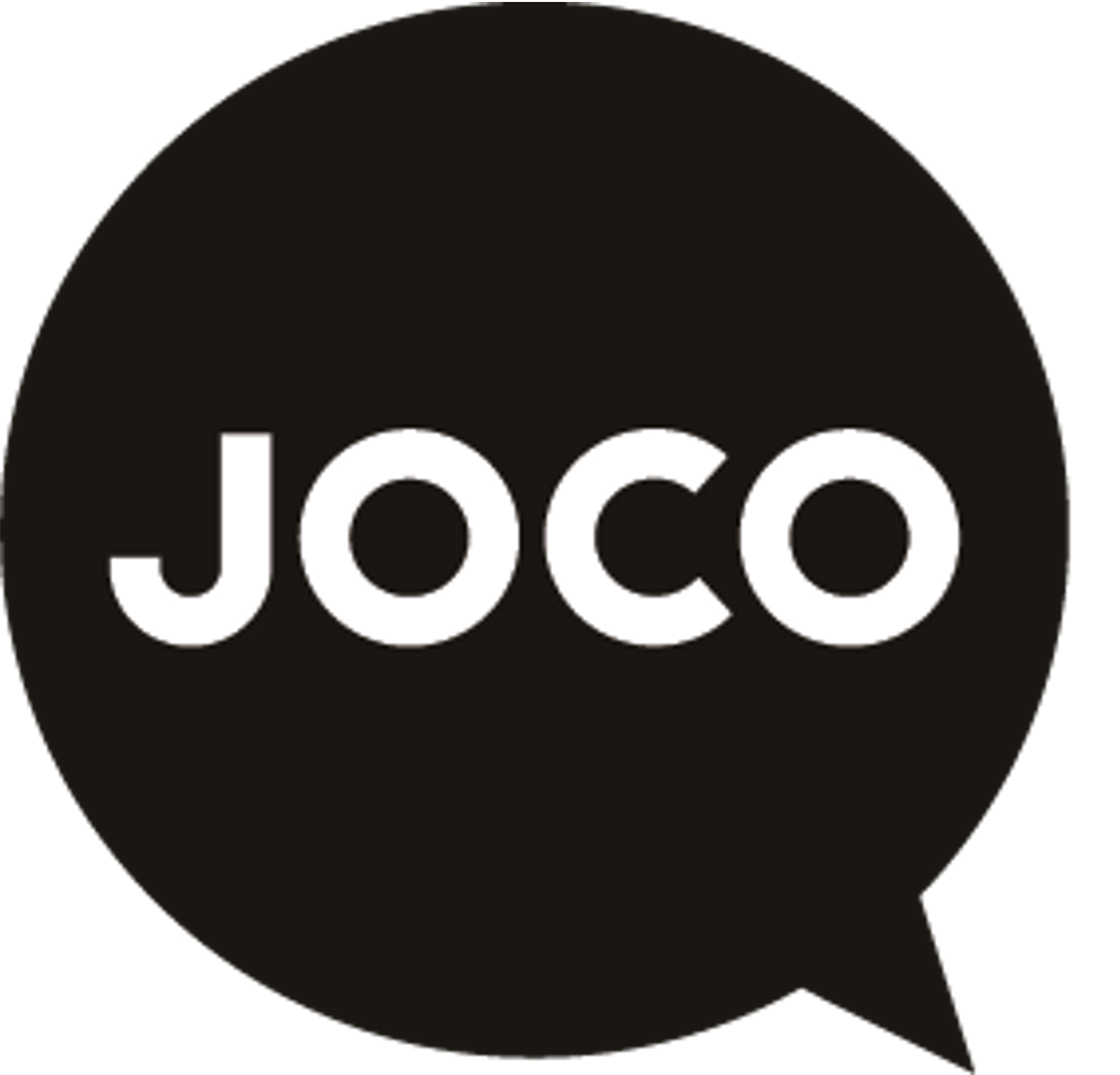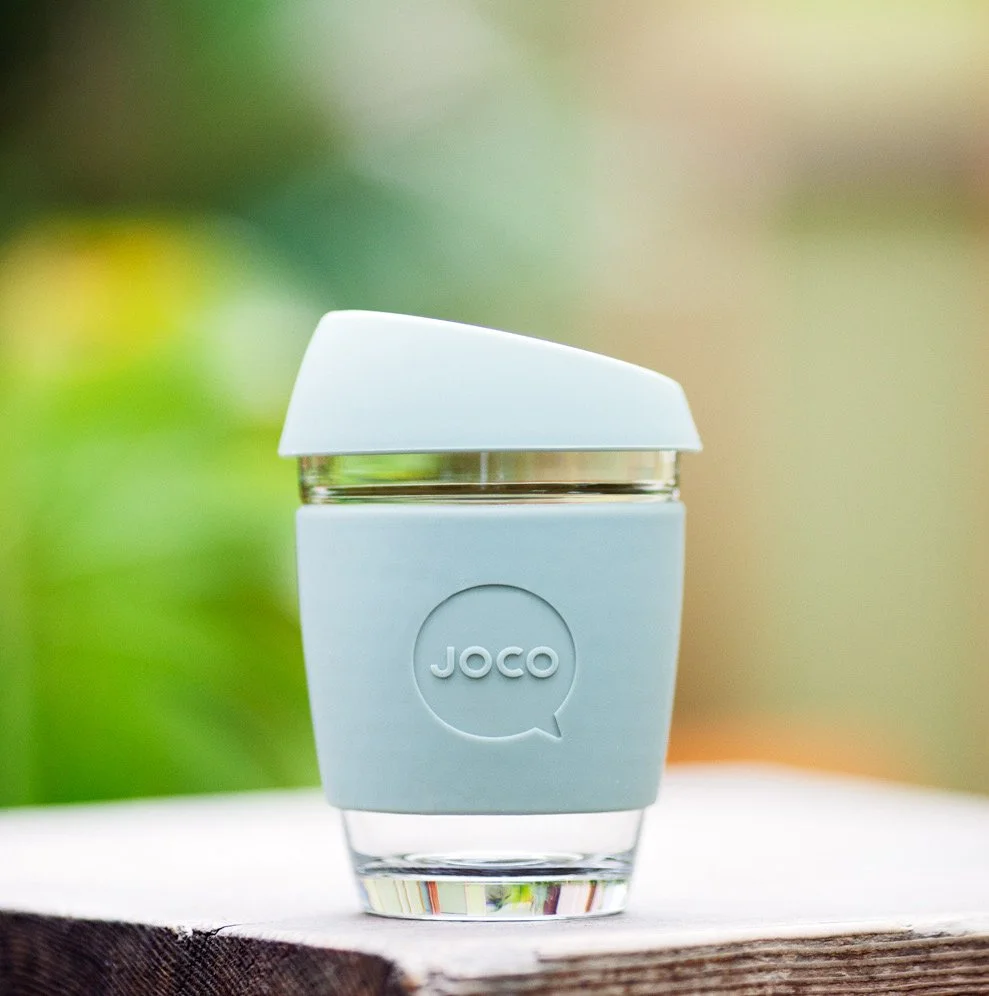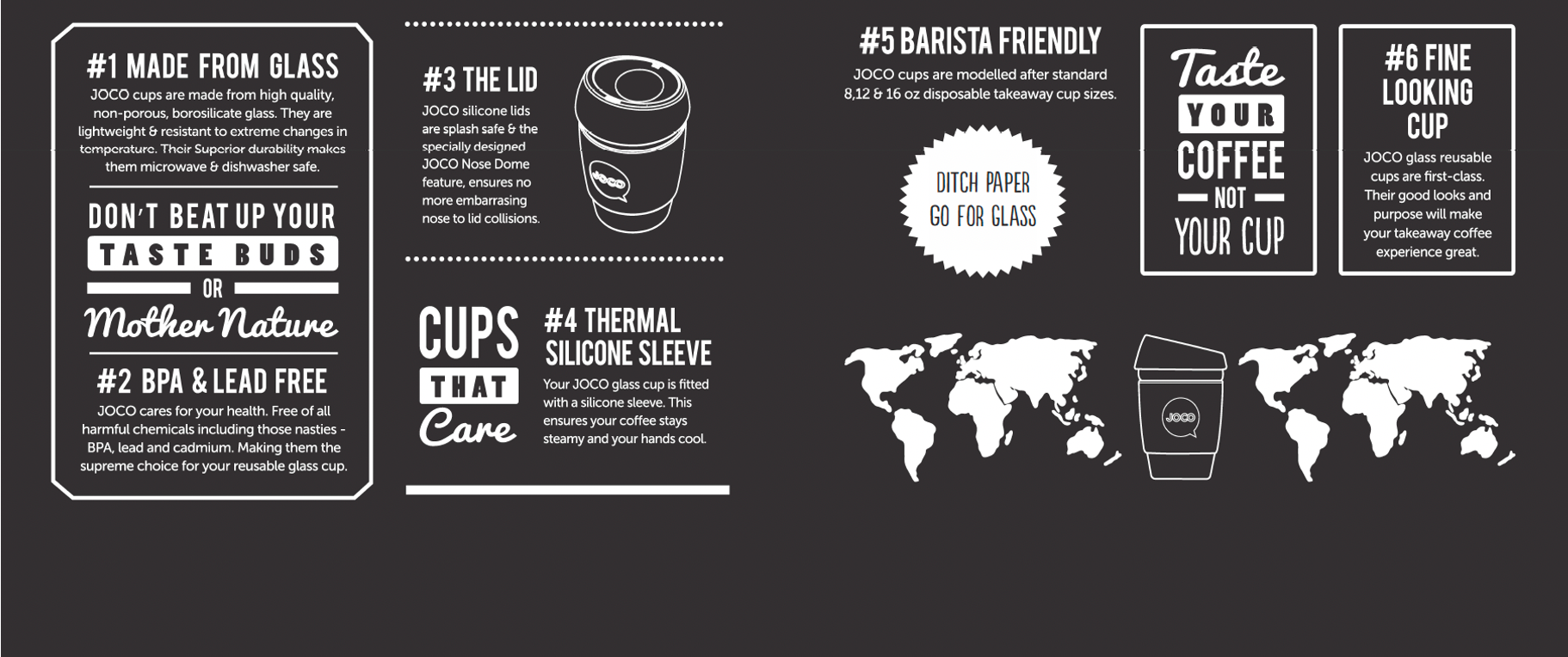HELLO
WE
ARE
JOCO.
In 2011 myself and co-founder began a start-up spawning from recognising the environmental impact of the takeaway coffee culture and the increasing use of disposable coffee cups among its patrons. Through preliminary competitor and user research we discovered opportunity based on:
The existing coffee & tea consumer trend
The environmental impact of disposable cups
Available market share
Our goal was to create a desirable reusable solution that did not detract but enhance the drinking experience of what many consumers valued as an important daily ritual, whilst creating awareness and consciences action towards climate change.
This was a broad initial goal, we knew immediately that it had the beauty of allowing us to explore an issue that could generally be dismissed; our relationship with the environment and willingness to change.
USER
RESEARCH.
We set about trying to understand the problem and who was going to interact with the product, their pains and gains with a quantitative and qualitative research approach. Framing out some initial unqualified personas, we targeted the research at these preliminary groups.
QUALITIATIVE
A series of interviews being semi-structured comprised of open and closed questions. The interviews were aimed at deriving insight into:
Emotional drivers with customers coffee routine
Customers attitudes towards disposable cups and the environment
Baristas attitude towards servicing reusable solutions
Pains with current journey
QUANTITATIVE
We created a survey with the goal of compiling data that can inform has on the prospective customer habits and journey. How many? How much? How often?
Average frequency of coffee consumed per week
Source of beverage, home or café
Size of coffee, 4oz, 8oz, 12oz, 16oz
Mode of transport during business hours
PROBLEM
STATEMENTS.
Drawing on the pains that identified from user research, I constructed a series problem statements that can assist in identifying the problem to be explored and actioned.
‘Customers need vessels that can be easily disassembled, because they want to be able to easily and quickly clean the product’.
‘People who go to cafes need reusable solutions that fit under machine group heads, because they buy takeaway coffee.’
‘Customers need a solution that keeps their beverage warm because they often drink over a period of time.’
‘People need aesthetically pleasing accessories, because they are fashion conscious’.
‘Customers need a product with replaceable components, because they don’t want to add to landfill with their product becoming redundant.’
DESIRABILITY
VIABILITY
FEASIBILITY.
Utilising the three lenses of human centered design developed by IDEO allowed for a quick evaluation of the JOCO solution.
Desirability
Responding to research findings and competitor research analysis to see if in fact JOCOs offering was a product a customer would value.
Feasibility
We had the resources to bring this product to life. Foreseen challenges lie ahead in terms of manufacturing capabilities.
Viability
Based on the global market size and coffee consumption statistics, defining our addressable and available market or share of wallet, the business viability looked promising.
220 Billion Disposable Cups
used worldwide annually
Coffee Within Top 10
traded commodities in the world
WorldCoffee Consumption 2010/2011
138.1 million bags (60kg per bag)
UNIQUE
VALUE
PROPOSITION.
JOCO’s cups are barista sized, reusable and the first glass vessel to the market. The existing barista sized solution available on the market was plastic. This directly affected the customer experience with the plastic tainting the flavour of the beverage. Our solution was lightweight, non-porous borosilicate glass.
User experience was paramount to the products success, after identifying the pains of the customer we needed to present a product that would naturally become a part of your daily ritual that you find joy in from a practical and cultural standpoint.
THE
DESIGN
PROCESS.
The design process involved a series of collaborative sessions brainstorming with our industrial designer ideating to meet the needs of our customer. The process involves a series of experimentation through sketching, low fidelity prototypes, 3D modelling and high-fidelity prototypes. The production of these prototypes allowed us to get the product in the hands of a customer, show baristas and gain key insights for further development. The process was in direct response to market needs and the insight from our customer research.
Our initial launch strategy entailed smaller production runs to test a smaller market which allowed us to validate the design and making necessary adjustments before investing in larger orders and launching to a larger market.
BRAND
AND
LANGUAGE.
We realised the value in building equity and a relationship with our customers with the JOCO brand. We were pioneers in the niche of barista sized reusable cups and conscious that JOCO was not immune from replications, and segment saturation.
It was important the customer and user experience was felt in every aspect of the brand and there consistency and continuity within the language and visuals of the brand. We also took inspiration from Apple and Bellroy’s end to end customer experience from the order process to the delight and detail in receiving the product.
Our language was designed to be personalable, approachable and conversational.
At JOCO every detailed mattered to create an experience that build loyalty with our customers. The tone of our language, our imagery and messages were about creating uniqueness in the market and becoming personable and relatable to our people. I realised the reality of copycats, and the importance of building brand equity.
DIGITAL STRATEGY.
The main challenge JOCO discovered is curving consumer habits and encouraging customers to embrace a viable long-term solution. Utilising a digital strategy to build a community, educate and engage customers was an important park of the customer journey.
CUSTOMER SUPPORT.
JOCO’s approach was an omni-channel customer service framework to support customers throughout their product journey. An omni-channel customer approach results in a seamless interaction with customers across all channels. satisfied customers reduces the probability of churn and increases the chances of referral or ‘word of mouth’.
Throughout my journey at JOCO we managed to grow the business and capitalise on an unsaturated market that was addressing a global environmental issue and releasing commercially viable solutions.



























